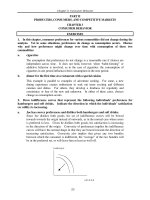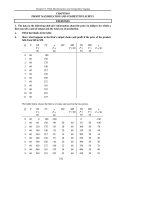Thuyết minh về thắng cảnh đà lạt bằng tiếng anh
Bạn đang xem bản rút gọn của tài liệu. Xem và tải ngay bản đầy đủ của tài liệu tại đây (1.4 MB, 10 trang )
Thuyết trình về thắng cảnh Đà Lạt bằng Tiếng Anh:
The name ”Da Lat” combines “Đà” which originates from “Đak”
and means “water” or “lake” in the local dialect, and “Lát” thethe
name of the local ethnic-minority group, a subsection of the Cơ
Ho group. The name ”Da Lat” thus refers to the water of the Lát
(lách) people. Da Lat. is home to many beautiful lakes; making it a
popular spot for travellers. The city has seen an influx of tourists in
recent years because of the international popularity ‘of ecotourism. “Now, the city is among the top ten tourist destinations
‘in Viet Nam. Climbing Lang Biang Mountain just north of Da Lat
and the many walking tracks surrounding the City are popular with
both residents and tourists.
Doctor and explorer Alexandre Yersin (1863-1943) founded the
French resort in Da Lat in 1895 because he thought the Lang Biang
Plateau was an ideal place for convalescence. Since that time, the
town and the surrounding rugged terrain have attracted a steady
stream of domestic and international tourists. Situated at an
altitude of 1,500 meters above sea level, Da Lat is 300 kilometers
north of Ho Chi Minh City and 110 kilometers inland from the
coast.
Da Lat is often referred to as the ”City of Eternal Spring” because
its average daily temperature varies between 15 and 24°C and is
often sunny. The rainy season falls between April and November,
with an average annual rainfall of 1.755 meters, while the dry
season is between December and March. This climate allows oa
Lat to grow flowers all year round, hence its other name, ”City of
Flowers.” A light mist often covers the mountains and fertile valley
fields surrounding oa Lat. Farmers ship fruits and vegetables
throughout Viet Nam; in fact, the road linking Da Lat with Ho Chi
Minh City is known as the ”Road of Fruits and Vegetables.”
Da Lat has a mixture of ethnic minorities as well as ethnic Kinh
(Vietnamese), who have moved there. Here is one of the few
places in Viet Nam where local residents wrap up in warm clothes
year round. The young girls of the region are renowned for their
pink cheeks. Ba Lat's city centre boasts an array of attractions for
tourists, who can visit its French-style university grounds, church,
and train station. The General Museum displays a good range of
indigenous artifacts and various objects of local historical
significance.
Visitors to Da Lat can also see palaces erected by French governors
and Vietnamese kings, including one built by Bao Dai, Viet Nam’s
last monarch. Da Lat is also home to at least ten ancient pagodas,
the most popular ones being Linh Son, Linh Phong, Linh Quang,
Thien Vuong Cố Sát, and Thien vien Truc Lam. Da Lat boasts one of
the oldest and most established golf courses in Viet Nam. Located
on hilly terrain near Xuan Huong Lake, the golf course has been
upgraded to international standards for eighteen holes.
Visitors will see a wide variety of flowers many of them rare along
the city’s streets, in its markets, and in the city’s parks and
nurseries. Da Lat’s horticulture industry is thriving; its flowers are
in demand throughout the country and are particularly popular in
Ho Chi Minh City. Da Lat’s oldest flower garden can be found near
Da Lat University and Xuan Huang Lake at 2 Phù đổng Thién Vuong
Street. Established in 1966 and opened to the public in 1985, this
garden displays a large collection of over 300 species and includes
local varieties as well as flowers from throughout the world. The
garden with its roses, Chrysanthemums, gladioli, orchids, and mi
mosa has flowers in bloom year round.
Da Lat boasts the highest concentration of flower species in Viet
Nam, with a concentration on oriental flowers such as purple
peach blossoms, violet Japanese daisies, yellow Chrysanthemums,
red Chinese hibiscus, jasmine, night orchids, and white lilies.
Growers have imported various rose species, such as Rosa Lutea
(which grows from the Middle East to China) and the Rosa I
ndicafragans
(which comes from Europe). Several newer rose species are
named for celebrities, such as the Brigitte for Bridgitte Bardot, the
John F. Kennedy, and Grace de Monaco, in addition to established
species. One unique flower to be found in or. Lat is the Salem. In
(960, a Vietnamese resident of Belgium introduced the flower,
which resembles bells with white, pink, and violet petals. Rose
lovers throughout the country prize this species, which travels
well.
About twenty species of Chrysanthemums and daisies bloom year
round. One of the most popular Species is Sans-souci (Worry-free),
in addition to Pensee, Violet, Cosmos, Immortal. Many species
that originated in North America, Mexico, Latin America, Africa,
and Europe now have Vietnamese names, such as Hoang Anh
(Verge d’or), Thu'q'c du’q'c (Dahlia), Thu hcii du’r‘mg (Begonia
Rex), Da hop (Magnolia), Mdm 561' (GueuIe-de-Loup), Ldng den
(Fuchsia). Phong If! (Geranium), Xac phao (Sauge Eclatante). Sen
da (loubarbe Des Toits), Sen can (Capucine).
A variety of cherry blossoms (Prunus Cerasoides) that is unique to
Da Lat blooms at Lunar New Years. This deciduous cherry tree,
which grows well in Da Lat’s temperate climate, sheds its leaves in
autumn and remains leafless throughout the winter. First
introduced to the region in the early twentieth century, this
variety differs from the Japanese cherry blossom, which cannot
grow in Da Lat’s climate. Da Lat has over 200 species of orchids,
with five indigenous species recently discovered. These five
feature ”Da Lat” or ”Lang Biang” in their names:
Dendrobium dalatense, Oberonic dalatensi, Eria dalatensis,
Dendrobium langbianense, and Oberonia langbianesis. These
indigenous species are in as much demand as the favourite locally
grown imported species: Balkis, Sayonara, Chateau, and Oriental
Legend. Growers sell their orchids both within Viét Nam and
overseas. Da Lat’s orchids grow naturally in fields in contrast to
European orchids, which must be grown in greenhouses that have
special heat, ventilation, and lighting systems, ‘
Flights to Da Lat operate from H5 Chi Minh City (thirty-five
minutes), and H51 Nc’ji (one hour and forty minutes). Motorists
can take two routes from H5 Chi Minh City. Highway 20 is a trip of
three hundred kilometers passing through Lam Dc’ing Province’s
lush Bio Léc District. Or they can take Highway 1 to Phan Rang and
then continue inland on Highway 27 through an area with historic
towers erected by the Cham ethnic minority, past the Da Nhim
Hydropower Plant, and across the stunning Ngoan Muc Pass with
its spectacular view of 03 Lat and the surrounding pine forests.
Xuan Hu’ong Lake (Fragrant Lake): Xuan Huang Lake is one of Da
Lat City’s most famous landmarks. Shaped like a crescent moon,
the lake covers five Square kilometers. Its clear waters and the
surrounding boulevards lined with trees make the park a favourite
rendezvous for lovers. Fishing is a popular pastime, as is riding the
pedal boats and relaxmg with a drink or a good meal in one of the
many cafes and restaurants lining the lake.
Than Thở (Lake of Lament): This lake just six kilometers east of Da
Lat’s centre, lies between pine-covered hills. Local legend has it
that the trees whisper a tragic love story that the lake witnessed
and retains: A young couple committed suicide there in order to
remain together. The light breeze across the water carries the
sounds of the lovers’ sobs. Visitors can see the gravesite that
symbolises the couple’s eternal convalesce.
Tuyén Lam (All Forest) lake): This lake, located close to the
popular Datanla Waterfall and formed by water from Tia Spring
and the upper section of Ba Tam River on Voi (Elephant)
Mountain, is a favourite for rowing and fishing. It is not clear when
or how the lake got this name suggesting its forested
environment. The water, the pines, and a nearby pagoda create an
atmosphere befitting solitary souls.
The government began building a dam at the site in 1982 to
ensure sufficient water to irrigate hundreds of hectares of rice
fields in Dt’tc Trong District and completed the construction in
1987. Ever since, the lake has been a popular tourist attraction for
tourists to Da Lat. A boat trip gives close-up views of the
surrounding hills covered in pines. Several endangered animals
inhabit the pine forests. Attractive tourist sites spot the lake
banks, including the hunting grounds of Bảo Dai (the last king of
the Nguyen Dynasty), 830 mi Waterfall, an area for raising buffalo,
and the hunting grounds, of the Lat, an ethnic-minority group. A
Zen monastery sits atop the hill north of the lake.
Da Nhim Lake: Situated some forty kilometers east of pa Lat on
the road to Phan Rang, this lake is worth the trip for its
spectacular scenery because it is located inside an inactive
volcano. After climbing the volcano, visitors are privileged to find a
panoramic view overlooking the surrounding mountains and
valleys. ,
Đa Thiện Lake: This lake in the ”Valley of Love” with the imposing
Lang Bian Mountain as its backdrop is a popular meeting place for
lovers.
Lak lake: In the Ê đê ethnic-minority language, ”Lak” means ”Lake
of Đắk Lắk Province.” The journey of 170 kilometers from Da Lat to
this lake passes through the scenic Truong Son Mountain Range
and by villages belonging to the M’Nong, E -dé, Churu, and Co Ho
ethnic minorities.
Prenn Waterfall: This waterfall ten kilometers from ea Lat lies at
the foot of Prenn Pass and is famous for its cascadea white satin
curtain falling over the footbridge located behind the falls Pine
forests and a variety of wild flowers surround the waterfall.
Pon Cour Waterfall: Many people regard this waterfall fifty
kilometers south of m Lat as one of the most magnificent in
lndochina. Although its drop is only forty meters, the waterfall has
a plentiful supply of water and carries religious significance for
local ethnic-minority people, who flock there for Lunar New Year’s
festivities and to pray for good luck in the coming year.
Ankroet Waterfall: This waterfall fifteen kilometers north of Da
Lat/and nearby Dankia Lake makes an attractive outing for
tourists. The road to the waterfall winds through ethnicminority
hamlets, where residents have vegetable farms.
Datanla Waterfall: This waterfall at the foot of Prenn Pass and near
Highway 20 is ten kilometers south of 0a Lat's city center. The
easiest way to get there is by motorbike taxi. The waterfall lies in a
valley not far from Tuyén Lam Lake. With its height of twenty
meters, Datanla Waterfall is not as steep as the ones at Prenn and
Pon Gour. lt slopes gently and falls gracefully, but its pool is deep.
After a walk of ten or fifteen minutes (about 300 meters) from the
pass to the waterfall, trekkers come to another path that follows a
long and steep slope. Youth like to jump from one rock to another
and worm their way through the bushes.
Vietnamese researcher Nguyen Diep says the “Datanla” comes
from the Co Ho phrase ”Ba Tam Nha,” which means ”water below
the rocks” and has been mispronounced as ”Datanla.” The banks
of the stream that flows into the Datanla once served as the base
and hiding places for the Lat people when resisting Cham
invaders. Eventually, the Lach drove out the invaders. Thereafter,
Datanla became a local resistance base whenever foreign groups
invaded.
Datanla’s scenery is wild and charming. It is said that nymphs from
Heaven once bathed there, hence the name ”Suo’i Tién” or
”Nymph Spring.” In 1998, the government classified Datanla as a
site of natural beauty.
Prenn Waterfall and Pass: Prenn Pass and Prenn Waterfall are
twelve kilometers from the center of Da Lat City and on Highway
20 near Datanla Waterfall. Prenn Pass, which is ten kilometers
long, lies at the entrance to Da Lat City. The thirteen-meter
waterfall is a hundred meters to the south of the slope of the
pass. At its foot is a bridge partly veiled by the rush of water. The
government recognised Prenn Waterfall as a site of national
beauty in 1998.
In the Cham language, ”Prenn” means ”an invaded area” or
”borderline.” Several centuries ago, the Cham in the Kingdom of
Panduranga on the east coast (present-day Ninh Thuan Province)
invaded the land of the Lat and the Chil, both related to the Co
Ho. Prenn was the border area and also the battlefront between
the two sides. The Cham lived on the stretch of land from Prenn
through D’Ran (Don Duang District, Lam Dong PrOVince) to Phan
Rang on the coast. The Co Ho, Lat, and Chil lived in the area on the
western side of Prenn. .
According to Chém history, this conflict took place in the
seventeenth century during the reign of King Porome (1625-1651),
who had great military strength and wanted to expand his
kingdom westward into the Lang Bian Highlands. However, the Co
Ho, the Lat, and the Chil clipped his ambition. The Cham occupied
D’Ran for a long time. Vestiges of the Cham dynasties can be
found in the area. Some villages in Don Duang District still bear
Cham names, such as K’loong and N’Thol Ha.
Cam Ly Waterfall: This waterfall is located only three kilometers
from the center of Da Lat, The waterfall is said to drop like a young
maiden’s long hair. ln Vietnamese, the words ”Cam Ly” evoke the
melancholia of love. The phrase has even found its way into the
lyrics of a song:
Dear Da Lat, do you hear Cam Ly
Weeping for its first broken love?
Cam Ly also is the name of the small stream flowing from Xuan
Huang Lake to the waterfall. The word ”cam ly” has several
meanings. In the most popular sense, it means ”giving in to
separation.” However, in old Chinese, ”cam” means ”satisfaction,”
”nice to the ear,” ”happy,” and ”sweet;” ”ly” means ”delicate” and
”water Soaking into the soil.” Some people believe the Waterfall
symbolises a stream of fresh, sweet .Water soaking into the hearts
of visitors.
Since the name ”Cam Ly” has existed for such a long time,
researchers have different theories about the Vietnamese nature
of the word. The first French envoy to Da Lat could not understand
why most place names in the area came from ethnic-minority
languages. By contrast, ”Cam Ly” sounds like the language of the
Kinh (ethnic Vietnamese) majority. One theory suggests ”Cam Ly”
is a phonetic variant of the name of a local ethnic hero, Darn M’Ly,
whose name means ”an indomitable man” in tho Lach language.
Dam M’Ly fought against the French when they first invaded Lang
Biang Plateau.
However, many people find the following story more convincing:
Once upon a time, there were three ethnic groups living side by
side on the banks of Cam Ly Spring and Xuan Huong Lake. The Lat
lived in the valley of Xuan Huang Lake; the Chil by the spring in the
area of Ba Hé Thuc; and the Co Ho, led by Chieftain K’Mly, at the
top of the waterfall. After K’Mly passed away, his tribe named the
area where they lived as well as the waterfall and the spring after
him. When spoken quickly, ”K’Mly” sounds like ”Kam Ly.” Later on,
people wrote ”Kam Ly” as ”Cam Ly,” which left the impression that
the name is of ethnic Kinh (Viét) origin.
Gougah Waterfall: Also called ”Pothole,” this Waterfall is located
thirty-eight kilometers from Da Lat and three hundred meters
from Highway 20. lt is seventeen meters high and has two falls,
one relatively quiet and the other gushing. ”Gougah” comes from
the ethnic-minority language, while ”Pothole” is an invention of
Kinh (ethnic Vietnamese) people to describe the eggshaped
stones that can be seen at the foot of the waterfall during the dry
season.
Lam Vién Plateau and Lang Biang Mountain: This area twelve
kilometers north of Da Lat includes Lang Biang Mountain, which
has the area’s highest altitude at 2,162 meters. It is popular with
both local residents and tourists interested in adventure sports
and in studying rare flora and fauna. Residents belong to the Lat,
Chil, and Ma ethnic minority groups.
The Valley of Love: This ar north of Ba Lat consists of hills, and
fragrant wild flowers and was known as the ”Valley of Peace”
during the reign of EmperoC; Bao Dai. In 1972, engineers butlt a
dam an created Da Thien Lake. The valley continues to attract
people, both young and old. ‘
The Forest of Elysium: This forest is thirtyeight kilometers south of
Da Lat and is close to Highway 20. It includes the Gougah Waterfall
and is noted for its raw, natural setting









